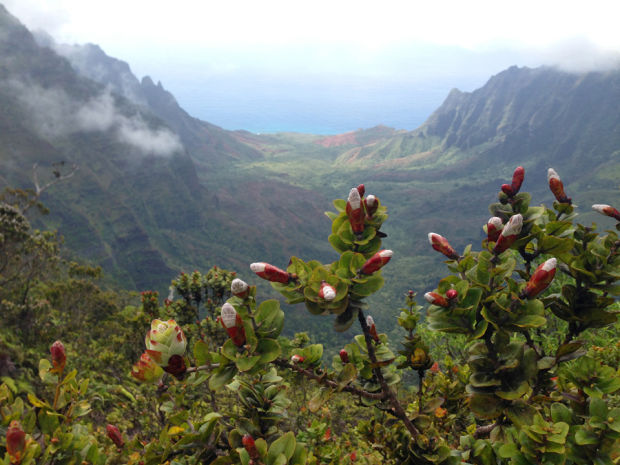LIHUE — The state Department of Land and Natural Resources is finalizing plans for a major reforestation on 1,000 acres of forest reserve land in and around Kokee. Expected to begin this fall, the project includes the removal of 15,000
LIHUE — The state Department of Land and Natural Resources is finalizing plans for a major reforestation on 1,000 acres of forest reserve land in and around Kokee.
Expected to begin this fall, the project includes the removal of 15,000 tons of eucalyptus and pine trees scorched during fires in the summer of 2012, followed by the replanting of native and non-invasive species.
DLNR Forestry Program Manager Sheri Mann described the task ahead as complicated, ground breaking and imperative.
“We feel like the forests really need this,” she said. “And that’s really why we’re doing it.”
And the DLNR has been given until June 30, 2016, to get it done it.
In January 2013, Gov. Neil Abercrombie green-lighted the Kokee Area Restoration and Reforestation project via an emergency proclamation. Its purposes included “mitigating the post-fire damage” from the three blazes that burned 3,000 acres in the Kokee area and eliminating the threat to public health and safety from potentially devastating post-fire effects, including flash flooding and erosion.
In addition to improving the forest and preventing future fires, Mann said the project will improve recreational uses.
“We really believe that when this whole thing is done there will be better opportunities for hunting, recreation and public access, and more safe, usable roads than there are now,” she said.
She estimated the project could cost up to $4 million.
The emergency proclamation technically allowed the department to complete the work without an environmental assessment. However, Mann said the DLNR is moving forward with one anyway, which she hopes will be out for public review later this year.
There will also be public meetings scheduled to address community concerns.
So far, no contracts have been finalized, but Mann said it is the department’s intention to utilize local businesses and labor whenever possible, including plant nurseries, trucks and equipment.
While a portion of the salvageable wood will be made available to the general public, the rest will likely be hauled to Green Energy Team, LLC’s $90 million biomass-to-energy facility near Koloa, scheduled to be in operation by the end of the year, according to Mann.
Gilles Lebbe, forestry manager at Green Energy, said that should his company finalize a contract with the state, the 15,000 tons would account for about 17 percent of the plant’s annual needs.
In a Jan. 16 letter addressed to “Interested Citizens of Kauai,” Lisa Hadway of the department’s Division of Forestry and Wildlife wrote about the future Kokee Restoration and Reforestation project.
“The next phase of this reforestation project involves removing dead trees and debris, and preparing the ground for extensive replanting,” she wrote. “We hope to start full operations in February or March 2014 and expect up to 10 logging trucks a day to be traveling on the roads from April through October 2014 depending on the weather.”
Due to the complexity, however, that timeline has since been pushed back.
The project has not come without red flags.
During a recent Kokee State Park Advisory Council meeting, several voiced concerns about the potential impacts to not only the environment, but roads, public safety and more.
“It’s hard to imagine all of the impacts,” said KSPAC member Erik Coopersmith. “It’s a logistical nightmare for me.”
Questions have also been raised about transparency.
“First of all, the community wasn’t informed,” said Mary Buza-Sims, KSPAC chair and principal of St. Theresa’s school in Kekaha. “The only reason I got wind of this is they notified the (Westside) schools in writing that this was taking place.”
If there is in fact an emergency in Kokee, Coopersmith wondered why the state has delayed implementing the emergency proclamation.
At its meeting, the KSPAC discussed its plans to establish a three-person permitted interaction group to get answers about what exactly the state has planned.
DLNR Education and Outreach Coordinator Dan Dennison said the public can expect outreach to increase in the coming months. With the particulars of the plan still being worked out, he said it is tough to provide a lot of information.
“This is an unprecedented situation that is being faced,” he said. “It takes time. It takes longer than people think.”
Mann said she understands the concerns about impacts to roads, Westside businesses, local communities and tourism, and that many details, including what time of day logging trucks will run, are yet to be decided.
“We plan on doing public hearings,” she said. “We want to know what the public thinks.”
• Chris D’Angelo, environmental reporter, can be reached at 245-0441 or cdangelo@thegardenisland.com.


